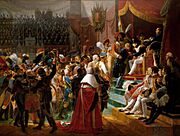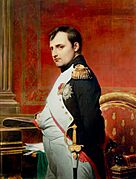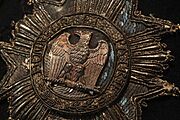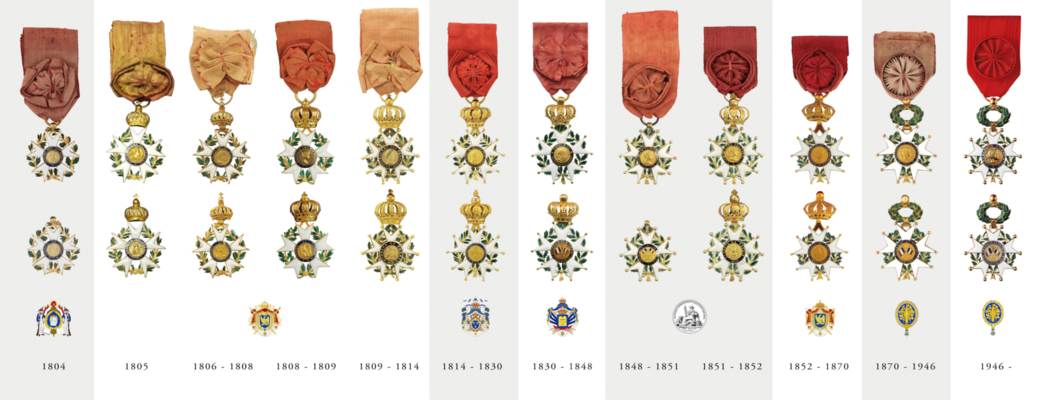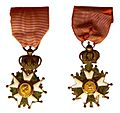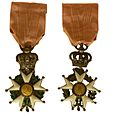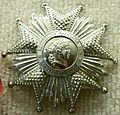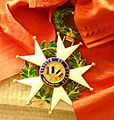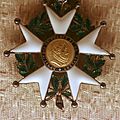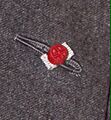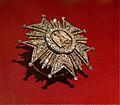Legion of Honour facts for kids
Quick facts for kids National Order of the Legion of Honour |
|
|---|---|
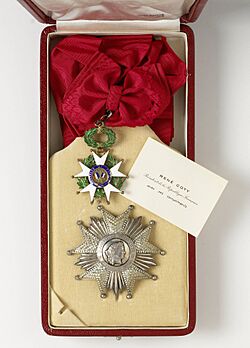
The silver version of the Grand Cross of the order given by President René Coty to Dutch Prime Minister Willem Drees
|
|
| Awarded by the president of France | |
| Type | Order of merit |
| Established | 19 May 1802 |
| Country | France |
| Motto | Honneur et patrie ("Honour and Fatherland") |
| Eligibility | Military and civilians |
| Awarded for |
Excellent civil or military conduct
delivered, upon official investigation |
| Founder | Napoleon Bonaparte |
| Grand Master | Emmanuel Macron, President of France |
| Grand Chancellor | François Lecointre |
| Secretary-General | Julien Le Gars |
| Classes |
(in 2010)
|
| Statistics | |
| First induction | 15 July 1804 |
| Precedence | |
| Next (higher) | None |
| Next (lower) |
|
|
Ribbon bars of the order |
|
The National Order of the Legion of Honour (in French, French: Ordre national de la Légion d'honneur) is France's most important award. It's given to people for amazing achievements. This special award recognizes both military heroes and civilians.
It was created by Napoleon Bonaparte in 1802. Since then, every French government has kept it. The award has five different levels, showing how important someone's contributions are.
The motto of the Legion of Honour is Honneur et Patrie, which means "Honour and Fatherland". The main office for the order is in a beautiful building in Paris. It's called the Palais de la Légion d'Honneur.
The five levels of the award, from lowest to highest, are: Chevalier (Knight), Officier (Officer), Commandeur (Commander), Grand officier (Grand Officer), and Grand-croix (Grand Cross).
Contents
History of the Legion of Honour
How the Award Began
Before the Legion of Honour, France had old awards called "orders of chivalry." These were mostly for noblemen. During the French Revolution, these old awards were stopped. Napoleon Bonaparte, who was then the leader of France, wanted a new way to reward brave soldiers and talented civilians.
So, in 1802, Napoleon created the Légion d'honneur. It was different from the old awards. It wasn't just for nobles; it was for anyone who showed great merit or bravery. Napoleon wanted to inspire people to serve France well. He famously said that people are motivated by "baubles" (meaning awards and honors). He believed that soldiers needed glory and rewards to fight bravely.
The Legion of Honour was also special because it was open to people of all backgrounds. This was a big change from the past. It was also a non-religious award, unlike many older ones.
Changes Through the Years
The Legion of Honour has been around for a long time. Because France's government changed many times, the award's look also changed.
First French Empire
When Napoleon became Emperor in 1804, the award's highest rank was called the Grand aigle (Grand Eagle). This rank came with a special cross and a silver star. Members of the Legion were even paid, with higher ranks receiving more money. For example, a grand officier received 5,000 francs.
The award was very visible during Napoleon's time. He always wore it himself. It was even rumored that a few women who fought with the army received the award.
- The Legion of Honour under the Empire
-
First Légion d'Honneur investiture, 15 July 1804, at Saint-Louis des Invalides by Jean-Baptiste Debret (1812)
-
A depiction of Napoleon making some of the first awards of the Legion of Honour, at a camp near Boulogne on 16 August 1804
Restoration of the Monarchy
After Napoleon, King Louis XVIII took over. He didn't get rid of the Legion of Honour. Instead, he changed its look. Napoleon's image was replaced with King Henry IV, and the imperial eagle was replaced with symbols of the royal family. The names of the ranks also changed slightly.
July Monarchy and Second Republic
When King Louis Philippe I came to power in 1830, the Legion of Honour became the most important French award again. Its design changed to include the French tricolour flags. By 1847, there were 47,000 members.
In 1848, France became a republic again. The award's design changed once more, bringing back Napoleon's image. In 1852, Angélique Duchemin became the first woman officially admitted to the order.
Second Empire and Third Republic
When Napoleon III became Emperor, an imperial crown was added to the award's design. Later, during the Third Republic (1871–1940), the crown was replaced by a wreath of laurel and oak leaves.
In 1871, the main building of the Legion of Honour in Paris was burned down during fighting. Many important records were lost. Later, in the 1880s, there was a scandal involving the awarding of these honors, which led to the resignation of President Jules Grévy. This showed how important it was to keep the award fair and honorable.
During World War I, many awards were given, including to foreign soldiers. This was also when awards could be given to soldiers who died in battle.
Fourth and Fifth Republics
After World War II, the Fourth Republic was formed in 1946. The award's design changed slightly again. When the Fifth Republic began in 1958, the design stayed the same. The current design has been in use since 1946.
How the Legion of Honour Works
Who Leads the Order?
The Legion of Honour is a special public organization in France. It follows its own set of rules, like a special law book. The President of France is always the Grand Master of the order. This means they are the main leader.
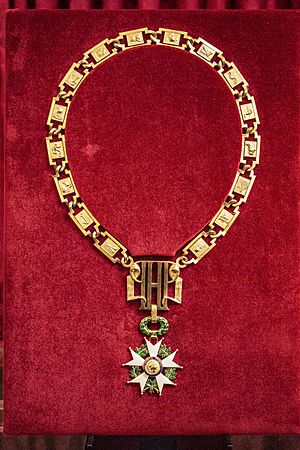
The current Grand Master is President Emmanuel Macron. He became the Grand Master on May 14, 2017. The Grand Master chooses all new members of the order, with advice from the French government.
The Grand Chancery
The daily work of the Legion of Honour is managed by a group called the Grand Chancery. It's led by a Grand Chancellor, who is usually a retired general. The current Grand Chancellor is General François Lecointre, who took office in 2023. There's also a Secretary-General, Julien Le Gars, who started in 2023.
The Grand Chancery also oversees other French awards. It runs special schools called the Legion of Honour Schools. These are boarding schools for daughters, granddaughters, and great-granddaughters of people who have received the Legion of Honour or other specific French awards. There's also a Legion of Honour Museum where you can learn more about the order.
Who Can Be a Member?
The Legion of Honour has five main levels, or "classes," that show how important someone's achievements are.
- Chevalier (Knight): This is the first level. You need at least 20 years of public service or 25 years in your job, showing great achievements.
- Officier (Officer): To reach this level, you need to have been a Knight for at least 8 years and continue to show excellent service.
- Commandeur (Commander): You need to have been an Officer for at least 5 years.
- Grand officier (Grand Officer): You need to have been a Commander for at least 3 years.
- Grand-croix (Grand Cross): This is the highest level. You need to have been a Grand Officer for at least 3 years.
"Eminent merits" means doing your job perfectly and going above and beyond. It means being creative, enthusiastic, and helping others grow and succeed.
There's a limit to how many people can be in each class at one time. For example, there can be a maximum of 75 Grand Cross members. However, some people, like World War II veterans or wounded soldiers, can be appointed outside these limits.
If a member commits serious wrongdoings, they can lose their membership in the order. It's also against the rules to wear the Legion of Honour decoration if you haven't earned it.
French Citizens
Both men and women who are French citizens can receive the Legion of Honour. They are recognized for their "eminent merit" in military or civilian life. This includes people like business leaders, government workers, scientists, artists, and even sports champions. All Olympic Gold Medal winners from France receive the Legion of Honour.
Usually, French citizens start at the Knight level. To move up, they need to keep doing great things for France. However, since 2008, people with "extraordinary careers" can sometimes enter at a higher level. For example, Simone Veil, a famous French politician and Auschwitz survivor, entered at the Grand Officer level in 2009.
Sometimes, people choose to decline the award, even if they are offered it. Famous composers like Maurice Ravel and Charles Koechlin did this.
International Recipients
Even though it's a French award, people from other countries can also receive the Legion of Honour. This happens if they have done something special for France or for the values France believes in. For example, foreign leaders often receive the Grand Cross as a sign of friendship. Veterans from countries like the United States and Britain who fought in the World Wars on French soil can also be eligible.
Awards for Groups
Collective appointments can be made to cities, institutions or companies. A total of 64 settlements in France have been decorated, as well as six foreign cities: Liège in 1914, Belgrade in 1920, Luxembourg City in 1957, Volgograd (the World War II 'Stalingrad') in 1984, Algiers in 2004, and London in 2020. French towns display the decoration in their municipal coat of arms.
Organisations to receive the honour include the French Red Cross (Croix-Rouge Française), the Abbaye de Nôtre-Dame des Dombes (Abbey of Notre-Dame des Dombes), the French National Railway Company (SNCF, Société Nationale des Chemins de fer Français), the Préfecture de Police de la Ville de Paris (Prefecture of Police of Paris), and various Grandes Écoles (National (Elite) Colleges) and other educational establishments.
Military Awards
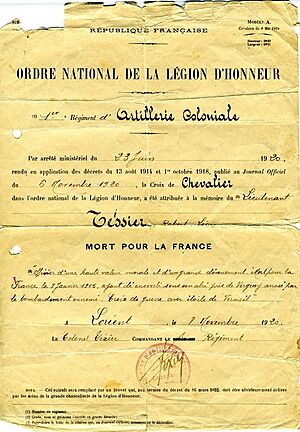
The military distinctions (Légion d'honneur à titre militaire) are awarded for bravery (actions de guerre) or for service.
- For extreme bravery: This is the highest award for courage in France. It's usually given to soldiers who showed incredible bravery, often in battle.
- For service: This award is given to military members who have served France with great dedication for many years.
Some military units also have their flags decorated with the Legion of Honour. This is a very special honor for the entire unit. For example, the U.S. Military Academy has received this award.
- 1st Foreign Regiment
- 1st Marine Artillery Regiment
- 1st Marine Infantry Regiment
- 1st Marine Infantry Parachute Regiment
- 1st Photographic Technical Unit
- 1st Parachute Chasseur Regiment
- 1st Regiment of African Chasseurs
- 1st Regiment of Algerian Tirailleurs
- 1st Regiment of Riflemen
- 1st Regiment of Senegalese Tirailleurs
- 1st Train Regiment
- 2nd Foreign Parachute Regiment
- 2nd Marine Infantry Regiment
- 2nd Regiment of Algerian Tirailleurs
- 2nd Regiment of Zouaves
- 3rd Algerian Infantry Regiment
- 3rd Foreign Infantry Regiment
- 3rd Regiment of Zouaves
- 4th Tunisian Tirailleurs Regiment
- 4th Regiment of Zouaves
- Joint 4th Regiment of Zouaves and Tirailleurs
- 7th Algerian Infantry Regiment
- 8th Infantry Regiment
- 8th Zouaves Regiment
- 9th Regiment of Zouaves
- 11th Marine Artillery Regiment
- 23rd Infantry Regiment
- 23rd Marine Infantry Regiment
- 24th Marine Infantry Regiment
- 26th Infantry Regiment
- 30th Battalion of Chasseurs
- 43rd Marine Infantry Regiment
- 51st Infantry Regiment
- 57th Infantry Regiment
- 112th Line Infantry Regiment
- 137th Infantry Regiment
- 152nd Infantry Regiment
- 153rd Infantry Regiment
- 298th Infantry Regiment
- Fighter Squadron 1/30 Normandie-Niemen
- Fusiliers Marins (Naval Infantry)
- Moroccan Goumier
- Paris Fire Brigade
- Régiment d'infanterie-chars de marine
Understanding the Awards
The Legion of Honour has five main levels, or "classes," each with its own special way of being worn:
- Chevalier (Knight): This badge hangs from a red ribbon on the left side of your chest.
- Officier (Officer): This badge is also on the left chest, but its ribbon has a small red flower-like shape called a rosette.
- Commandeur (Commander): This badge is larger and hangs around your neck from a red ribbon.
- Grand officier (Grand Officer): You wear the Officer's badge on your left chest, plus a silver star on your right chest.
- Grand-croix (Grand Cross): This is the highest level. You wear a badge on a wide red sash that goes over your right shoulder. You also wear a shiny gold star on your left chest.
The Design of the Medal
The main part of the award, called the badge, looks like a five-pointed star with "arrowhead" shaped arms. It's usually made of shiny gold (or silver for Knights) and has white enamel. Between the arms, there's a green wreath made of laurel and oak leaves.
In the middle of the badge, on the front, you'll see the head of Marianne. She is a symbol of the French Republic. Around her, it says "French Republic" in French. On the back, there are crossed French tricolour flags. Around them, you'll see the motto "Honour and Fatherland" and the date the order was founded.
The star (or plaque) is worn by Grand Officers and Grand Cross members. It looks like the badge but doesn't have enamel. Instead, it has shiny rays between its arms. The star also features Marianne's head and the motto.
The ribbon for all levels of the medal is a simple, plain red.
When to Wear the Award
People usually only wear the full badge or star during special ceremonies or with formal uniforms. For everyday wear, they use a smaller red ribbon or a rosette on their clothes. Women often wear a small lapel pin called a barrette.
Gallery
See also: Category:Legion of Honour in heraldry
-
Louis XVIII era (1814) Knight insignia: the front features Henry IV's profile and the rear, the arms of the French Kingdom (three fleurs-de-lis). A royal crown joins the cross and the ribbon.
-
Chiang Kai-shek's Légion d'honneur plaque. In his day, the plaque was not gilded in gold.
-
Charles Lindbergh's Legion of Honour
See also
 In Spanish: Legión de Honor para niños
In Spanish: Legión de Honor para niños
- List of Légion d'honneur recipients by name
- List of British recipients of the Légion d'Honneur for the Crimean War
- List of foreign recipients of the Légion d'Honneur
- Musée national de la Légion d'honneur et des ordres de chevalerie
- Ribbons of the French military and civil awards







